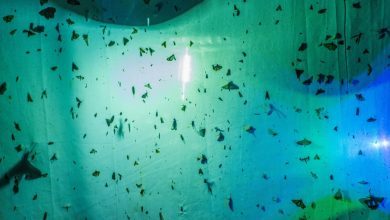Don’t Let Your Wine Go to the Grocery Store Naked

Wine is about experience. It’s about a subtle taste and a pleasant buzz. The slow crafting of a drink over months and years. It can also be about downing cheap fermented grape juice as fast as possible. Who’s to judge?
Some things that probably don’t come to mind when considering the wine experience: sauerkraut, marmalade, wet dog. But these smells are produced by a chemical reaction called light strike when wine, particularly white wine and rosé, is exposed to ultraviolet light or high frequency visible light. According to Fulvio Mattivi, a food chemist at the Edmund Mach Foundation in Italy, “every technician knows about it.” It is part of the reason wine is stored and aged in cool, dark places and why bottling methods are so important.
“But then the final decision as to what goes on the market is up to the head of marketing” for each wine company, said Dr. Mattivi, who, with collaborators, recently published a paper in the Proceedings of the National Academy of Sciences about the way bottle color affects light strike in wine on grocery store shelves.
White wines and rosés are often sold in clear bottles made of a refractive material called flint glass to show off their color, and while standard fluorescent lights in grocery stores do not produce the same amount of high frequency light as direct sunlight, the damaging wavelengths are still present. Dr. Mattivi’s most recent research shows that just a week on supermarket shelves in these bottles can lead to the “production of stinky compounds.”
“With exposure, you can have a very bad wine,” said Dr. Mattivi.
Winemaking itself occurs in the shadows. “There’s really no exposure to light at all until it hits the bottles,” said Gage Oughterson, a winemaker at Highland Cellars Winery in New York. He noted that light strike effects are “definitely a consideration” in the winemaking world. “It just seems like the marketing department has won over the development department,” he said.
The Science and Wonders of Smell
Learn more about our often disregarded, and at times startling, superpower.
- Perks of Evolution: Genetic changes to our olfactory receptors have altered people’s sensitivities to some odors over time.
- Lessons From Covid: The loss of smell and parosmia experienced by some have opened new doors to understanding the most neglected sense.
- The Nasal Ranger: For a half-century, Chuck McGinley has visited society’s stinkiest sites in order to measure, and demystify, smell.
- Pushing Boundaries: The perfumer David Moltz has created a thought-provoking collection of perfumes inspired by history and religion.
“The things we bottle in clear bottles are generally wines that have a color we want to show off,” said Ian Barry, a winemaker in the Finger Lakes in New York who started putting a majority of his lighter wines in flint glass bottles because they sold better in grocery stores. “For instance, it’s very important when people decide which rosé to buy.”
Mr. Barry added that people interested in naturally produced wine have seemed more receptive to clear bottles. “I don’t know if that’s because they’re literally transparent,” he said.
Frederick Frank, a third generation winemaker in New York, said that, in addition to bottling decisions stemming from a desire to show off wine’s brilliant hues, there is a tradition around the color of wine bottles. At least at his family’s wineries, semi-dry wines are often bottled in amber, while dry wines are bottled in green. Whatever clear bottles lack in historical significance, they make up for in commercial success. Rosé, chardonnay, sauvignon blanc and pinot gris are all typically bottled in flint glass. “We just hope that people don’t leave the bottle out in the sun,” said Mr. Frank.
Even though light strike has been a well-known effect for at least half a century, winemakers and scientists have been unsure of its chemical origins and how fast it occurred under different conditions. To study it, Dr. Mattivi and his colleagues stored more than 1,000 bottles of wine in an imitation grocery store. This was part of a larger project to understand the effects of shelf storage on wine, growing out of a 2020 paper in which Dr. Mattivi and his colleagues showed that wine in clear bottles developed a bad smell after a couple weeks in the store. But what was happening on a molecular level?
Wines of different types in different color bottles were periodically chemically analyzed. Two aromatic compounds, norisoprenoids and terpenes, which can, in different concentrations, lend the drink a smell of baked apples, flowers, saffron, citrus, spicy cloves or fish oil, were found to have been significantly affected in wine kept in clear bottles after just a week in the grocery store. Wine in green bottles did not exhibit the same kind of chemical change, even after 50 days on the shelf, and wine stored out of the light remained almost completely stable.
In addition, Dr. Mattivi found that the chemical compositions of different wines became more similar the longer the wines were stored on the shelf in clear bottles. “The wine will be simply less characteristic,” he said.
“I think there’s definitely a perception that a wine in a clear bottle is less serious than wine in a darker bottle,” Mr. Barry said, when told of the new study. He added that knowing the science behind it could change the way he chooses bottle colors.
Mr. Oughterson noted the new study’s importance for wine connoisseurs but said, “as long as the stores are turning over quick enough, I don’t think it’s anything that the average consumer is going to pick up.”
Dr. Mattivi, on the other hand, said that wine simply should not be stored in clear bottles. He brought up the Hans Christian Andersen folk tale of an emperor who was convinced by crafty swindlers that his new clothes were beautiful, despite his inability to see them. Surrounded by yes men, the emperor continued to buy imaginary clothes and eventually put them on to parade through town. A child, unburdened by social norms, said: “But he hasn’t got anything on!”
Dr. Mattivi continued: “Wine in clear bottles is naked.”




